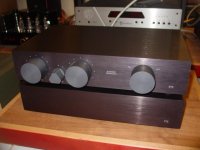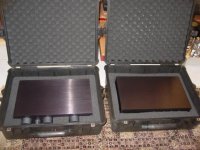I am glad to hear this. My associates and I have searched the world for these parts and we continue to do so. We have paid up to twice as much per device with orders of 1000. This is why I was so worried that the vendor (might) not understand the order, or might think that the parts could be ordered through Toshiba, ultimately. We have had two stituations like this already. Once, the wrong parts were delivered, something completely different. Another time the deposit had to be returned because the vendor realized that the order could not be completed.
What concerned me most was the CHOICE of parts. Either Bl or V. Usually there is no choice left with existing stocks, so we often trade among ourselves to get what we really want. Some need Gr, some Bl, and I prefer V, for example.
I certainly hope that there is even more stock, that will be available to amateurs.
What concerned me most was the CHOICE of parts. Either Bl or V. Usually there is no choice left with existing stocks, so we often trade among ourselves to get what we really want. Some need Gr, some Bl, and I prefer V, for example.
I certainly hope that there is even more stock, that will be available to amateurs.
bogdan_borko said:Does anyone has a photo of the blowtorch, I`d like to see what it looks like...
go to first pages of thread
With all the respect I can`t say it`s state of the art chassis design. It looks to classic to me, but it`s ok.
That`s my opinion.😉
That`s my opinion.😉
Of course, we did not hire a design house to make this product. We just put it together, ourselves. For the record, no more preamps are being made, like this. It was just too expensive to make.
There will not be any new Blowtorch preamp. My business partner, who designed the case and did the wiring, is dead. Has been for about 2 years. We were going to discontinue production, even before that. It became too expensive to produce.
Fellow audiophiles, just because the Blowtorch will not be made in future, does not make the 'principles' that made it, any less. It was designed as an all-out, low compromise design, without global feedback in the line stage. It was as much an experiment as a commercial product, and it was successful sonically. It just became too expensive to produce, and our audiophile base was saturated. It is just like when Porsche did not make any further 959 autos, after the first 200 or so. This does not mean that we will not use the ideas and approaches used in the Blowtorch in newer designs. In fact, we are already using the power supply of the Blowtorch in our upcoming Vendetta Research phono preamp design. It is better than the original Vendetta power supply, that is for sure.
I do the same thing. If I do something and it works, I use it in the next circuit and bootstrap from one improvement to the next to the next. The circuit for my main tube amp isn't all that amazing. I did, however, put more time, care, and attention (and money) into the power supply than previous designs and was amply rewarded for my trouble.
Grey
Grey
Fellow audiophiles, I want to again point out what our experience has shown us. When it comes to audio, all bets are off. You just can't measure a device, and be sure that it will sound as good or better than another device. If this were not true, we could have switched to IC op amps for almost everything, decades ago. At the same time, I am not suggesting that keeping or adding some form of distortion is OK. I try to remove virtually all the distortion from my circuits as it is possible and practical to do, especially if it does not involve adding negative feedback.
I have also found problems in AC balancing circuits (to remove residual second harmonic) yet I can't prove why. In this case, however, I can measure the problem with a special test called the Hirata test. So, here we are: Less THD, or more Hirata distortion? I chose less Hirata distortion, because Marantz tube amps measure low in Hirata distortion, and Crown amps measure high in Hirata distortion. I am sure there is a correlation.
Now, this is a DIY website and some attention should be put to practical DIY projects. My first recommendation is that you make SIMPLE circuits, either tube or solid state, rather than complex circuits. You can BUY complex circuits, or at least, similar sounding circuits at your local electronics warehouse and at a much cheaper price than what you can make it for. Why bother duplicating the Ford Festiva, or the Skoda Estelle?
On the other hand, it is almost impossible for any newbie amateur to make a Vendetta, because it takes too much matching and experience to do it properly. I know that some people would like to try, but I recommend against it.
Still, there are many designs discussed here, a few from me, and many from Nelson Pass, that are possible, practical, and will sound darn good. Personally, I would recommend that you stick with those.
Audio quality is NOT a numbers game, even though low numbers may be applauded for their technical success. Leave that for servos, and other industrial applications.
I have also found problems in AC balancing circuits (to remove residual second harmonic) yet I can't prove why. In this case, however, I can measure the problem with a special test called the Hirata test. So, here we are: Less THD, or more Hirata distortion? I chose less Hirata distortion, because Marantz tube amps measure low in Hirata distortion, and Crown amps measure high in Hirata distortion. I am sure there is a correlation.
Now, this is a DIY website and some attention should be put to practical DIY projects. My first recommendation is that you make SIMPLE circuits, either tube or solid state, rather than complex circuits. You can BUY complex circuits, or at least, similar sounding circuits at your local electronics warehouse and at a much cheaper price than what you can make it for. Why bother duplicating the Ford Festiva, or the Skoda Estelle?
On the other hand, it is almost impossible for any newbie amateur to make a Vendetta, because it takes too much matching and experience to do it properly. I know that some people would like to try, but I recommend against it.
Still, there are many designs discussed here, a few from me, and many from Nelson Pass, that are possible, practical, and will sound darn good. Personally, I would recommend that you stick with those.
Audio quality is NOT a numbers game, even though low numbers may be applauded for their technical success. Leave that for servos, and other industrial applications.
HIRATA
John,
Hirata distortion is new to me. Thanks for bringing it up. I found these articles (which I bought) at the AES web site.
JAES Volume 29 Number 9 pp. 607-610; September 1981 :
"Study of Nonlinear Distortion in Audio Instruments"
by YOSHIMUTSU HIRATA
Acoustic Research Section, Waseda University, Tokyo 160, Japan
and
JAES Volume 29 Number 4 pp. 243-248; April 1981 :
"Nonlinear Distortion Measurement Using Composite
Pulse Waveform"
by YOSHIMUTSU HIRATA, MASAAKI UEKI, TOMOAKI KASUGA
61-504 Acoustical Lab., Waseda University, Tokyo 160, Japan
The references in the first article above points to an article that I could not find, though. It is called "Pulse response and transient distortion of audio instruments" from 1978. It might be the case that it is available in Japan only.
Regards,
Sigurd
John,
Hirata distortion is new to me. Thanks for bringing it up. I found these articles (which I bought) at the AES web site.
JAES Volume 29 Number 9 pp. 607-610; September 1981 :
"Study of Nonlinear Distortion in Audio Instruments"
by YOSHIMUTSU HIRATA
Acoustic Research Section, Waseda University, Tokyo 160, Japan
and
JAES Volume 29 Number 4 pp. 243-248; April 1981 :
"Nonlinear Distortion Measurement Using Composite
Pulse Waveform"
by YOSHIMUTSU HIRATA, MASAAKI UEKI, TOMOAKI KASUGA
61-504 Acoustical Lab., Waseda University, Tokyo 160, Japan
The references in the first article above points to an article that I could not find, though. It is called "Pulse response and transient distortion of audio instruments" from 1978. It might be the case that it is available in Japan only.
Regards,
Sigurd
Mr.Curl,
How do you measure the Hirata distortion? You make the meter yourself or is there a commercial hirata distortion meter unit?
How do you measure the Hirata distortion? You make the meter yourself or is there a commercial hirata distortion meter unit?
Jim Lesurf gives some hints about that (or what I think it is) here:
http://www.audiomisc.co.uk/distortion/page1.html
Personally I don't have hands-on info about this asymmetric Hirata test signal (as given in the patent), also I prefer the shaped cosine bursts which is also described in the Lesurf article.
- Klaus
http://www.audiomisc.co.uk/distortion/page1.html
Personally I don't have hands-on info about this asymmetric Hirata test signal (as given in the patent), also I prefer the shaped cosine bursts which is also described in the Lesurf article.
- Klaus
Jim Lesurf does a VERY good job of explaining what is going on with the Hirata test. I don't have the internal knowledge of the test box in order to explain it any better.
Matched N and P Ch JFETs (Perhaps)
Last month I posed the question to Linear Systems about whether they have any plans to build a matched P-Ch pair to complement their dual N-Ch LSK389. Interestingly, they said thay have such a device in the works and that I should check their website (www.linearsystems.com). Assuming that such devices do become available, I plan to buy a bunch of both the P-Ch and N-Ch parts and experiment with a line amp design I have been contemplating.
Last month I posed the question to Linear Systems about whether they have any plans to build a matched P-Ch pair to complement their dual N-Ch LSK389. Interestingly, they said thay have such a device in the works and that I should check their website (www.linearsystems.com). Assuming that such devices do become available, I plan to buy a bunch of both the P-Ch and N-Ch parts and experiment with a line amp design I have been contemplating.
- Status
- Not open for further replies.
- Home
- Amplifiers
- Solid State
- John Curl's Blowtorch preamplifier



